Building AAC Facilitation Skills with Tabi Jones-Wohleber: MASTER PAL Training, Module 5
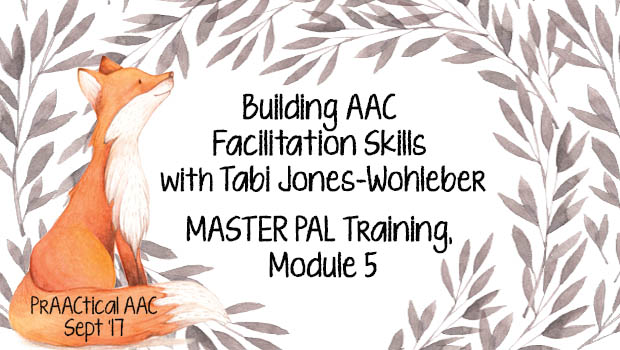
 Our AAC Training Series continues today and we are incredibly grateful to Tabi Jones-Wohleber for sharing these presentation materials with us. Today’s training materials center on a topic that is near and dear to my prAACtical heart: Using statements more often than questions.
Our AAC Training Series continues today and we are incredibly grateful to Tabi Jones-Wohleber for sharing these presentation materials with us. Today’s training materials center on a topic that is near and dear to my prAACtical heart: Using statements more often than questions.
The instructional time for Module 5 is about 90-120 minutes which allows time for discussion and practice.
:::::::::::::::::::::::::::::::::::::::::::::::::::::::::::::::::::::::::::::::::::::::::::::::::::::::::::::
Model as a MASTER PAL
Module 5: Statements More Than Questions
Facilitator Guidelines
STATEMENTS MORE THAN QUESTIONS
Questions are necessary to help us learn about the things, people, and activities in our environment and beyond. However, interactions heavily weighted with questions do not often yield the quality exchanges required to build relationships, gain understanding, foster autonomous communication or facilitate initiation. This module explores the power of statements (aka nondirective language and descriptive teaching) in shaping meaningful engagement for learning and socially interacting. It includes interactive activities, video links, lots of discussion, and ample examples.
Here are some things you will need for this session.
Supplemental Handout(s):
Warm-up Discussion
| Thinking Prompt | Making Connections / Talking Points |
| Consider the interaction when you are making plans with a friend: -Where do you want to go? -I don’t know? -What are you in the mood for? -Anything really. How about you? …Yada yada yada … |
This is a relatable experience. When we are in a position where we have to make multiple decisions, we become overwhelmed. We hedge, feel rushed, feel pressured. In the end, our decision is not always what we would have chosen had we been given ample time or fewer questions. We may choose hastily, or dismiss a choice with “never mind”. You may have questions of your own that you don’t feel at liberty to ask. Simply put, we are not at our best when barraged with questions. In these instances, the pressure is on.
Dominating interactions with questions creates 1-sided interactions, and limits opportunities for reciprocity. The only appropriate response is the one that answers the question. It provides limited opportunities for communicative functions beyond responding. It backs the AAC user into a corner and does not provide him/her the option to change, terminate or otherwise influence the direction of the interaction. |
| And what does it feel like to order at an unfamiliar restaurant with an extensive menu?: -What can I get you? -How do you want it cooked? -With everything? -What kind of salad dressing? -What kind of bread? -Salad before your meal or with it? -Drink? etc….. |
The Discourse
| Topics Addressed | Slide(s) | Talking Points / Examples |
| Title Slides | 1-2 | N/A |
| Communication Review | 3-7 | Review of Model as a MASTER PAL and AAC to ensure all participants are on the same page. |
| Interactive Activity: Part 1 | 8 | Instructions for participants are on the slide.
Facilitator Instructions: Provide each group a card. Give a scoring card to the recorder ONLY. Other group members should not see the scoring card. You do not want them to know the scoring criteria. Facilitate beginning and ending time of discussion. Purpose: Most often educators interact with individuals who use AAC by predominantly asking questions (to make choices, answer yes/no, ask opinions). This is a pre-test of sorts, to gain information about the participants’ default behaviors when interacting with an AAC user. It is important that the “teacher” in the scenario lead the interaction in a genuine role-play. Just discussing core vocabulary that could be used is NOT a role-play. This is important because the way the vocabulary is used in “core vocab brainstorming activity” is different from the way vocabulary is used in more realistic interactions. Folks often “get it right” when brainstorming, but not when actually interacting. The purpose of this interaction is to highlight the behaviors related to actual interactions. The Activity: Follow directions on the slide. Discussion: When the activity is finished, tell the recorder to write his/her name on the scorecard, and collect them. Share that this activity will be revisited later in the session. |
| Introduction & Warm-up Discussion | 9-11 | Explained on Slides.
See chart above for Warm-up Discussion |
| Understanding the role of questions and statements in interactions | 12-14 | Explained on Slides. |
| Impact of Directive Statements | 16 | Explanation of example 1 on the bottom half of the slide:
It is important to identify the purpose of the “find the…, show me…, etc” statements; to demonstrate learning OR to engage in a communicative interaction.
For example:
|
| Intended vs. Actual Outcomes of Directive Language | 17-19 | The facilitator should decide how to use the information on these slides, in whole or part. Slide 16 references the webinar from which this information was taken; the webinar is linked. The companion handout is included as a supplemental handout below. The times on the slide indicate the key reference points in the webinar that addresses the intended vs. actual outcomes of directive language. Slides 18-19 are screenshots from the webinar. |
| Understanding Non-Directive Language | 20-24 | The facilitator should decide how to use the information on these slides, in whole or part. Slide 20 is an introduction of Non-directive language. Slide 21 links to the webinar from which this information was taken. The companion handout is included as a supplemental handout below. The times on the slide indicate the key reference points in the webinar that addresses the intended vs. actual outcomes of directive language. Slides 22-24 are screenshots from the webinar. |
| Valid and Genuine Questions | 25-28 | The facilitator should decide how to use the information on these slides, in whole or part. Slide 25 links to the webinar from which this information was taken. The companion handout is included as a supplemental handout below. The times on the slide indicate the key reference points in the webinar that define valid and genuine questions. Slides 25 & 27 are screenshots from the webinar. Slide 26 is an example of valid questions using a descriptive teaching approach. These examples were taken from a handout created by Gail Vantatenhove. The link to the original handout is in supplemental handouts below. |
| Teach AMPLY, before you TEST (question) | 29 | This interactive slide is a transition between theory and application. Now that we know why non-directive and descriptive vocabulary are important, it walks participants through what “good teaching”looks like when these strategies are applied. It highlights the progression from “introducing→ engaging in discourse→ and extending knowledge” about a topic/content area BEFORE testing a student’s understanding. The teaching components of this progression are comprised primarily of descriptive and non-directive language. |
| Interactive Activity: Part 2 | 30 | Repeat the previous activity, but give everyone a different topic card. Participants should assume the same roles. Once completed, discuss how the information from the session influenced how they interacted this time compared to the first time. Most will express increased awareness of their interaction patterns. Depending on the cooperativeness of the communication partner, some may express feeling more “in control” when making statements”. This is a VERY valuable observation, that is also very true of our students who use AAC. When we ask questions, they have the power to respond or not. And if they don’t, they often back their communication partner into a corner of asking more questions. We can redirect the conversation and increase opportunities for modeling with statements more effectively than with questions. |
| Examples of Teaching with Non-Directive Language and Valid Questions | 31-34 | These animated slides reveal descriptive language related to a topic, followed by valid questions. Note the responses primarily consist of core vocabulary and directly reflect the statements used to teach the topic. The dark box around the question on slides 30-31 are answered by the descriptive language provided as an example. Invite participants to generate teaching phrases that could elicit the responses to the additional valid questions provided as examples. |
| Examples of Leisure Activities with Non-Directive Language and Valid Questions | 35-36 | Further examples of how non-directive language and valid questions can be used across contexts. Note: these examples are comprised of core vocabulary. |
| Video of Descriptive Language in Action | 37 | A 5-minute video from a 45-minute lesson in a vocational classroom, in which core vocabulary and descriptive language are used to enable students to respond to a valid question. |
| Practice activity using descriptive and non-directive language. | 38-39 | These images are to prompt participants to identify a topic/content area. They then identify a valid question(s) and generate descriptive and non-directive phrases to teach the content that will answer the question.
Participants may also choose to use a topic that they will be teaching. This activity may be done individually, in pairs, as homework, or as a whole group. |
| AAC is not intuitive | 38 | Final Thought. |
| Let’s Re-Cap | 39 |
|
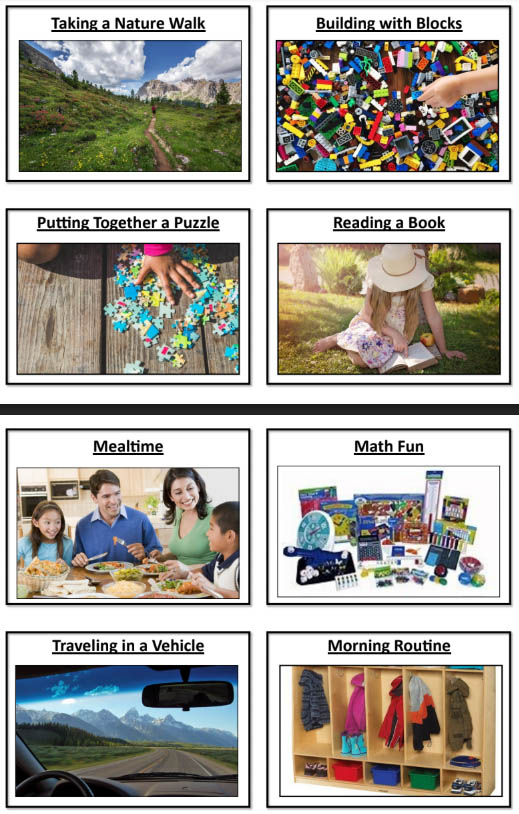
Supplemental Handouts
Video Links
- Don’t Ask, Do Tell (YouTube Webinar by Maureen Nevers)
- Future Flowers (video of classroom lesson)
Interactive Activities / Discussions
- Slide 8 & Slide 30: The same activity is repeated, once before learning, and then during learning. The activity cards and scoring sheet are available here.
- Slides 38-39 prompt participants to put into action what they have learned about non-directive language, descriptive language and valid questions.
- Headbanz (game), Heads Up (mobile device app): These activities may be used in place of or in addition to slides 38-39. They require participants to use descriptive language and core vocabulary to give their partner information about the image on her forehead (that she can not see). It results in ample use of non-directive statements.
Extension Resources
- Angelman Syndrome Foundation –
- Webinar #12: Don’t Ask, Do Tell. Non-Directive Language
- Webinar #24: Descriptive Language
- Assistiveware:
- Do’s and Don’ts of AAC – Questions
- Do’s and Don’ts of AAC – Core Words
- PaTTAN – Power AAC, Module 8: Teach Vocabulary
- Project Core – Embedding Communication Throughout the Day
::::::::::::::::::::::::::::::::::::::::::::::::::::::::::::::::::::::::::::::::::::::::::::::::::::::::
You can view the previous modules using the links below.
Filed under: Featured Posts, PrAACtical Thinking
Tagged With: AAC training
This post was written by Carole Zangari
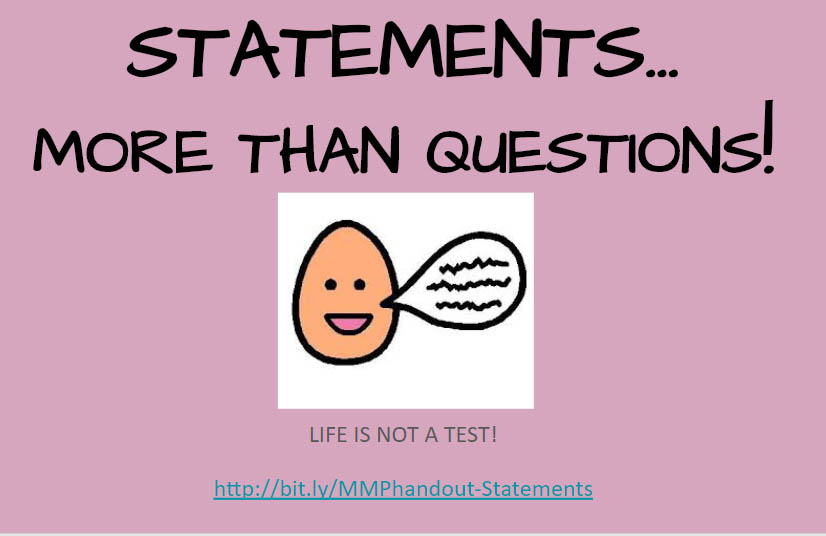

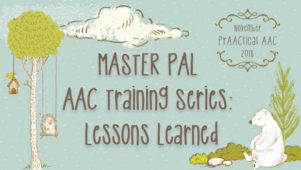
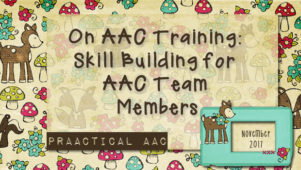
1 Comment
thanks.when i have time i will watch .can your info be applied to the four blocks of literacy.what guides sites .information sites do you recomend to teach us to teach educate our child who has no literacy skills and has severe cerebral palsey.your site looks good.we will attempt home schooling as normal public main stream has not worked.